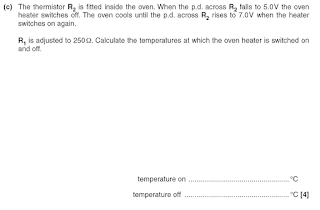This blog contains answers to exercises set for students. While every effort is made to ensure that the information posted is correct, mistakes may occur from time to time.
Search This Blog
Friday, December 04, 2020
Wednesday, December 02, 2020
Electric Fields Revision Questions
3. (a) appropriate shape; lines perpendicular to
and touching plate and sphere; (2)
arrows towards negative sphere (1) 3
(b) (i) By moments, e.g F cos 20 = W sin 20 / by
triangle of forces /
by resolution of forces / other suitable method; i.e. justification needed
(1)
F = 1.0 × 10–5 tan 20; =
1.0 × 10–5 × 0.364; (= 3.64 × 10–6 N) (2)
triangle of forces gives W/F = tan 70, etc (1) 3
(ii) E
= F/Q; = 3.64 × 10–6 / 1.2 ×
10–9 = 3.0 × 103;N
C–1 / V m–1 3
(c) E
= (1/4πεo)Q/r2; 3.0 × 103 = 9 × 109 × 1.2 × 10–9/r2;
(2)
or use F = (1/4πεo)Q2/r2; r2 = 3.6 × 10–3 giving r = 6 × 10–2 (m) (1) 3
(d) field line sketch minimum of 5 lines symmetrical
about line joining
centres with arrows; (1)
Fig 1 sketch matches RHS of Fig 2/plate analogous to mirror/AW
relating to symmetry (1) 2
[14]
(i) Suitable recognisable pattern around (not
just between) the charges B1
Quality mark: symmetry, spacing, lines joined to charges B1
Consistent arrows toward B on some lines B1
(ii) Use
of E = (1/4πε0)Q/r2 C1
Sum of two equal terms
E = 2 × 9 × 109 × 1.6 × 10–19 / (2.0 × 10–10)2 C1
E = 7.2 × 1010 N C–1 or V m–1 A1
(iii) The
separation between the ions because this has an effect on the
breaking force. (Allow the size of ionic ‘charges’) B1
[7]
y12 Electricity revision question on Christmas tree bulbs and 2 lamps
1. (a) either (If in parallel) when one bulb fails, other
bulbs stay on
or (If in parallel) can
identify which bulb has failed; (1) 1
(b) (i) P = VI (1)
0.5 = 240 I
I = 2.1 × 10–3 A 1
s.f. in answer (–1) once only (1) 2
(ii) R
= V/I (1)
= 240/(2.1 × 10–3)
= 1.14 × 105 Ω or 1.15
× 105 Ω ans
accept (1.1 to 1.2) × 105 Ω. (1) 2
(iii) A
= ρ l / R (1)
= 1.1 × 10–6 × 6.0 ×
10–3 / (1.14 × 105)
(= 5.79 × 10–14 m2)
A = πr2 (1)
5.79 × 10–14 = πr2 so r = 1.4 × 10–7 m (1) 3
(iv) filament
too thin / fragile to be manufactured / used without damage;
allow ecf from (iii). (1) 1
4
[20]



































